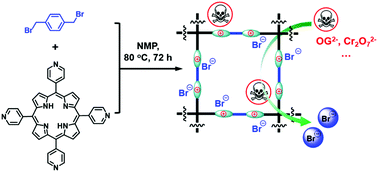Construction of a cationic organic network for highly efficient removal of anionic contaminants from water†
Abstract
Widespread water contamination has become a great threat to human survival, and therefore developing an efficient strategy for decontamination of wastewater is of great significance. Herein, a new cationic organic network (CON-1) has been constructed by a facile method from commercially available precursors, 1,4-bis(bromomethyl)benzene (BBMB) and 5,10,15,20-tetra(4-pyridyl)porphyrin (TPP), via a quaternization reaction. After being well characterized, CON-1 was employed as an adsorbent for removal of anionic contaminants in aqueous media. Benifitting from the charged framework and exchangeable counter ions, CON-1 exhibits fast adsorption kinetics and high adsorption capacity towards organic dyes and dichromate. The maximum adsorption capacity for the organic dye orange G and Cr2O72− can reach up to 718 mg g−1 and 293 mg g−1, respectively. Moreover, CON-1 displays good stability in the adsorption process, it can be regenerated and it can be reused for several cycles. The facile synthesis, high efficiency, and good stability endow CON-1 with great potential in the purification of wastewater.



 Please wait while we load your content...
Please wait while we load your content...